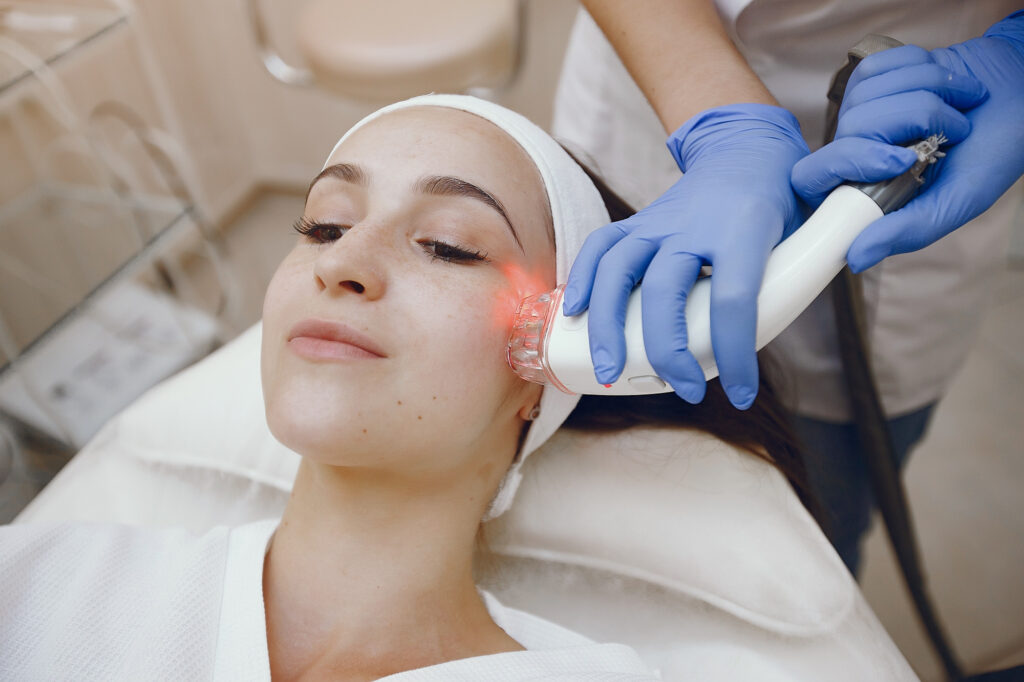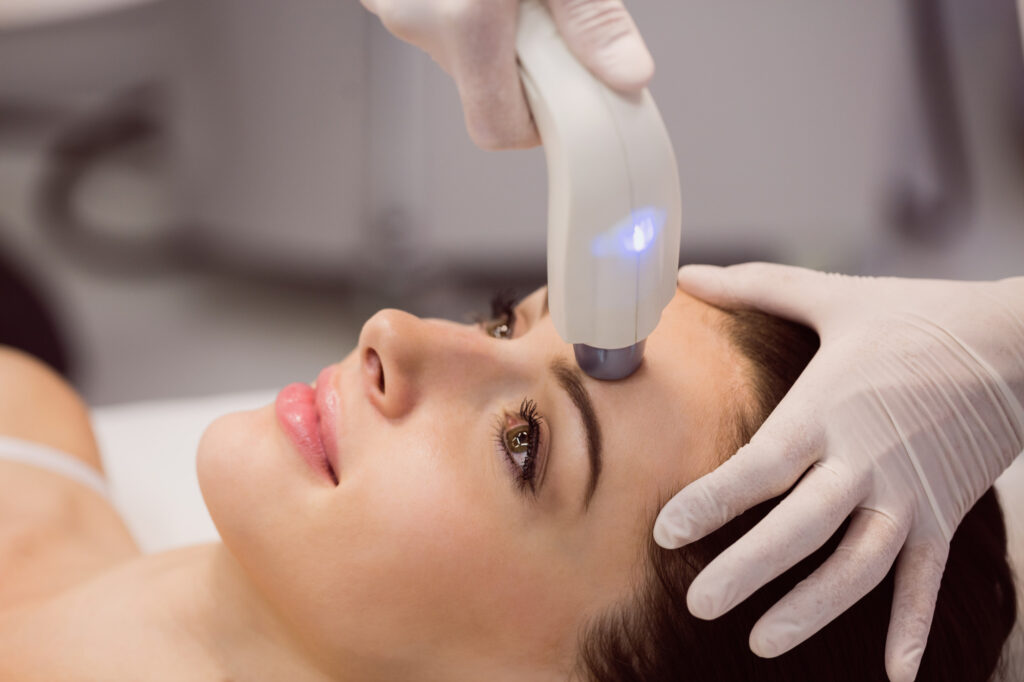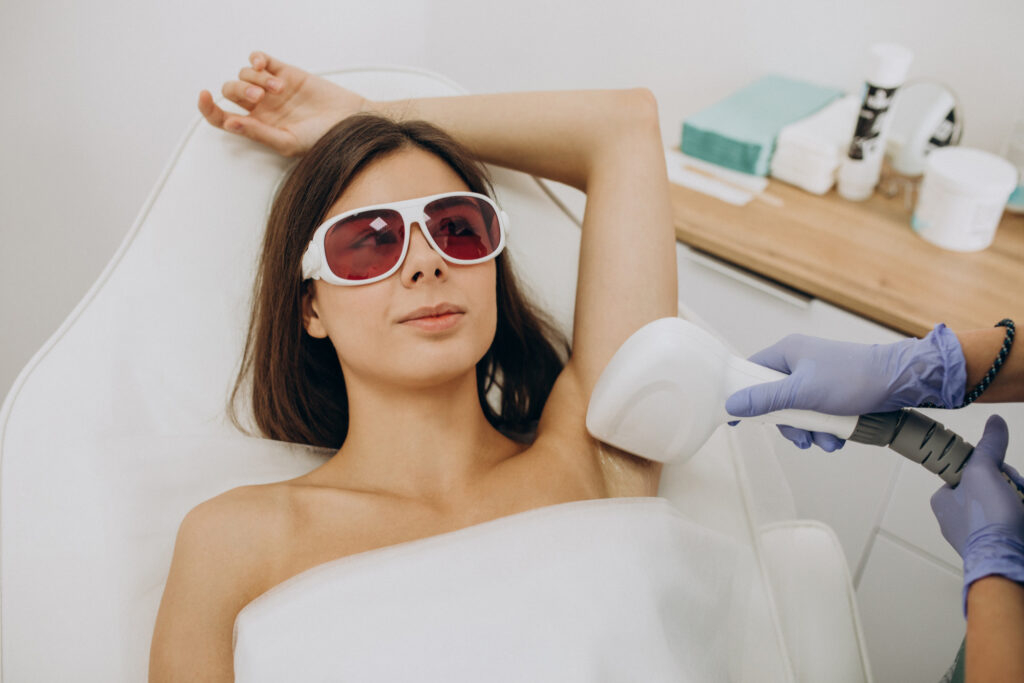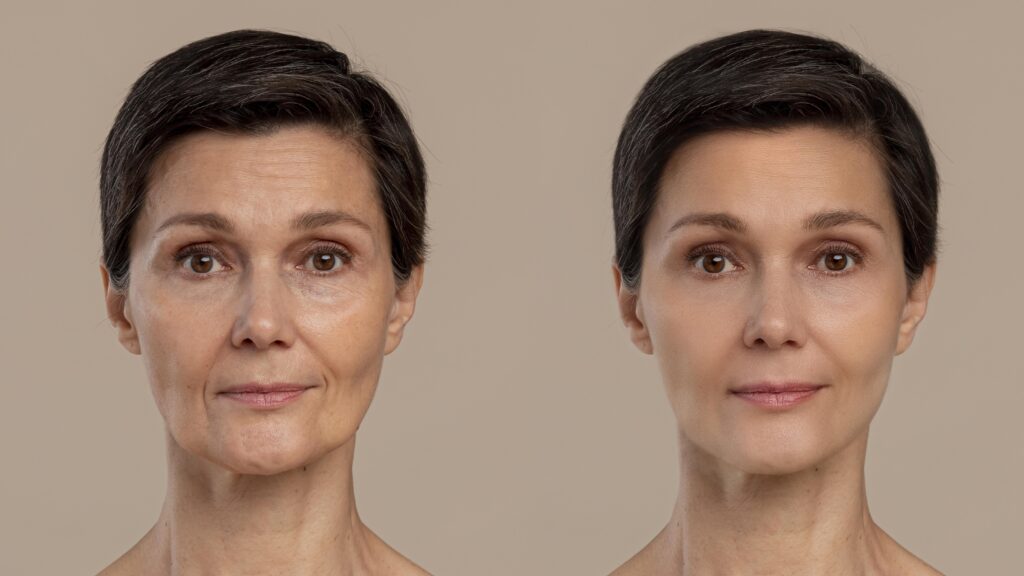
Laser skin resurfacing is a popular cosmetic procedure that many people turn to when they want to improve their skin’s appearance. Whether you’re dealing with wrinkles, scars, or uneven skin tone, this treatment can help you achieve smoother, younger-looking skin. In this article, we’ll break down everything you need to know about laser skin resurfacing in simple, easy-to-understand language. By the end, you’ll feel well-informed and ready to decide if this treatment is right for you.
What is Laser Skin Resurfacing?
Laser skin resurfacing is a procedure that uses a laser to improve the appearance of your skin. The laser removes the outer layer of damaged skin, revealing fresh, new skin underneath. This process can reduce the appearance of wrinkles, scars, age spots, and other skin imperfections.

There are two main types of laser resurfacing:
- Ablative Laser Resurfacing: This type removes the outer layer of skin and heats the underlying skin, which stimulates collagen production and leads to smoother, firmer skin. It’s very effective but comes with a longer recovery time.
- Non-Ablative Laser Resurfacing: This type doesn’t remove the skin’s outer layer but heats the underlying skin to promote collagen production. It has a shorter recovery time, but the results are usually less dramatic than ablative treatments.
Who Should Consider Laser Skin Resurfacing?
Laser skin resurfacing can be a good option for you if:
- You have fine lines or wrinkles around your eyes, mouth, or on your forehead.
- You have shallow scars from acne.
- You have non-responsive skin after a facelift.
- You want to improve your skin tone and texture.
However, not everyone is a good candidate for laser skin resurfacing. You might want to avoid this treatment if you:
- Have active acne or very dark skin.
- Have deep wrinkles or sagging skin.
- Are pregnant or breastfeeding.
- Have a history of keloid scars or are prone to scarring.
It’s always best to consult with a dermatologist to determine if laser skin resurfacing is right for you.
How to Prepare for Laser Skin Resurfacing
Before you undergo laser skin resurfacing, your dermatologist will likely advise you to:
- Stop Smoking: Smoking can slow down the healing process, so you’ll need to quit at least two weeks before the procedure.
- Avoid Certain Medications: Some medications can increase the risk of complications, so you may be asked to stop taking them for a while.
- Use Sunscreen: Protecting your skin from the sun is crucial, as sun damage can interfere with the healing process.
- Follow a Skincare Routine: Your dermatologist may recommend specific skincare products to use before the treatment to prepare your skin.
What to Expect During the Procedure
Laser skin resurfacing is usually performed as an outpatient procedure, which means you can go home the same day. The treatment typically takes between 30 minutes and two hours, depending on the size of the area being treated.
Here’s what happens during the procedure:
- Preparation: Your skin will be cleaned, and you’ll be given protective eyewear.
- Anesthesia: To minimize discomfort, your dermatologist will apply a numbing cream or give you a local anesthetic. In some cases, you might receive sedation.
- Laser Application: The laser will be carefully passed over the treatment area, removing or heating the skin’s outer layers.
- Post-Treatment Care: After the procedure, your skin will be covered with a special ointment and bandages to protect it during the initial healing phase.
Recovery and Aftercare
The recovery time for laser skin resurfacing varies depending on the type of laser used and the size of the area treated. Here’s what you can generally expect:
- Ablative Laser Resurfacing: The recovery period can last between one to two weeks. During this time, your skin may be red, swollen, and itchy. It’s essential to keep the treated area clean and moisturized and avoid picking at any scabs.

- Non-Ablative Laser Resurfacing: Recovery is typically shorter, with most people returning to their regular activities within a few days. However, you may still experience some redness and swelling.
During the recovery period, it’s crucial to protect your skin from the sun. Use a broad-spectrum sunscreen with an SPF of 30 or higher, and avoid direct sunlight as much as possible. Your dermatologist may also recommend using specific skincare products to aid in healing and enhance your results.
Potential Risks and Side Effects
Like any cosmetic procedure, laser skin resurfacing comes with some risks and potential side effects. These can include:
- Redness and Swelling: These are the most common side effects and usually subside within a few days to a few weeks.
- Infection: There’s a small risk of infection after the procedure, especially if the treated area isn’t properly cared for.
- Scarring: In rare cases, laser skin resurfacing can cause scarring, particularly in people prone to keloids.
- Changes in Skin Color: Some people may experience hyperpigmentation (darkening of the skin) or hypopigmentation (lightening of the skin) after the treatment.
To minimize these risks, follow your dermatologist’s aftercare instructions closely and report any unusual symptoms immediately.
How Long Do the Results Last?
The results of laser skin resurfacing can be long-lasting, but they aren’t permanent. As you age, your skin will continue to change, and new wrinkles and age spots may appear. However, you can prolong your results by taking good care of your skin.
- Use Sunscreen: Protect your skin from the sun to prevent further damage.
- Follow a Skincare Routine: Use products recommended by your dermatologist to keep your skin healthy and hydrated.
- Avoid Smoking: Smoking can accelerate the aging process, so quitting can help maintain your results.
Cost of Laser Skin Resurfacing
The cost of laser skin resurfacing can vary widely depending on several factors, including the type of laser used, the size of the area treated, and your location. On average, you can expect to pay between £1,000 and £2,500 per session.
It’s important to note that most health insurance plans don’t cover cosmetic procedures like laser skin resurfacing, so you’ll likely need to pay out of pocket. However, many clinics offer payment plans or financing options to help make the treatment more affordable.
How to Choose the Right Clinic
Choosing the right clinic for your laser skin resurfacing treatment is crucial to achieving the best results. Here are some tips to help you make the right choice:
- Research: Look for clinics with positive reviews and testimonials from previous patients.
- Check Credentials: Ensure that the clinic is staffed by qualified dermatologists or cosmetic surgeons who are experienced in laser skin resurfacing.
- Ask Questions: Don’t hesitate to ask about the clinic’s experience with the specific type of laser you’re interested in, as well as their safety protocols.
- Consultation: Schedule a consultation to discuss your goals and concerns. This is also a good opportunity to assess the clinic’s professionalism and customer service.
Final Thoughts
Laser skin resurfacing is a powerful tool in the fight against aging and skin imperfections. By removing damaged skin and stimulating collagen production, it can help you achieve smoother, younger-looking skin. However, it’s essential to understand the procedure, potential risks, and aftercare requirements before deciding if it’s right for you.
If you’re considering laser skin resurfacing, consult with a qualified dermatologist to discuss your options and create a treatment plan tailored to your needs. With the right approach, you can enjoy beautiful, rejuvenated skin that boosts your confidence and makes you feel your best.
For more information about skin care and cosmetic treatments, you can visit reputable sites like the British Association of Dermatologists or NHS for detailed guidance and resources.
FAQ: Everything You Need to Know About Laser Skin Resurfacing
- What skin issues can laser skin resurfacing address?
Laser skin resurfacing is a versatile treatment that can address a wide range of skin concerns. It is particularly effective for reducing the appearance of fine lines and wrinkles, especially around the eyes and mouth. The procedure can also help diminish the look of acne scars, surgical scars, and other types of facial scars. Additionally, laser resurfacing can improve skin tone and texture by treating sun damage, age spots, and uneven pigmentation. For those with large pores or a rough skin surface, laser treatment can result in smoother, more refined skin.
- How does laser skin resurfacing work?
Laser skin resurfacing works by using concentrated beams of light energy to remove or heat the outer layers of damaged skin. This process stimulates the body’s natural healing response, leading to the production of new collagen and the regeneration of fresh, healthy skin cells. Depending on the type of laser used—ablative or non-ablative—the procedure may either remove the surface skin (epidermis) or penetrate deeper into the dermis to promote collagen growth without removing the outer skin layer. The result is a reduction in wrinkles, scars, and blemishes, revealing a smoother, more youthful complexion.
- What are the different types of lasers used in skin resurfacing, and how do they differ?
There are two primary types of lasers used in skin resurfacing: ablative and non-ablative lasers. Ablative lasers, such as CO2 and Erbium lasers, remove the outer layers of the skin, which is highly effective for treating deep wrinkles, scars, and significant skin damage. The CO2 laser is particularly powerful and is often used for deeper resurfacing, while the Erbium laser is a bit gentler, making it suitable for treating moderate lines and sun damage with a shorter recovery time.
Non-ablative lasers, like fractional lasers and intense pulsed light (IPL), work by heating the underlying skin tissue without removing the top layer. These lasers stimulate collagen production, leading to skin tightening and rejuvenation with minimal downtime. Non-ablative treatments are less invasive and are often chosen for milder skin issues or for those who cannot afford a lengthy recovery period.
- What is the recovery process like after laser skin resurfacing?
The recovery process after laser skin resurfacing depends largely on the type of laser used. After an ablative laser treatment, you can expect a more extended recovery period, typically one to two weeks. During this time, your skin may be red, swollen, and tender, and you may experience peeling or crusting as the outer layer heals. It’s crucial to keep the treated area clean, moisturized, and protected from the sun to prevent infection and promote healing. You may also need to avoid makeup and other skincare products until your skin has fully healed.
For non-ablative laser treatments, the recovery time is much shorter, often just a few days. You might experience mild redness and swelling, similar to a mild sunburn, but these symptoms usually subside quickly. Regardless of the type of laser used, it’s essential to follow your dermatologist’s aftercare instructions closely to ensure the best results.
- Are there any risks or side effects associated with laser skin resurfacing?
As with any cosmetic procedure, laser skin resurfacing carries some risks and potential side effects. Common side effects include redness, swelling, and itching, which are generally temporary and subside as the skin heals. However, more serious complications can occur, such as infection, scarring, and changes in skin pigmentation. Hyperpigmentation (darkening of the skin) or hypopigmentation (lightening of the skin) may develop, especially in individuals with darker skin tones. To minimize these risks, it’s important to choose a qualified dermatologist or plastic surgeon with experience in laser treatments and to follow all pre- and post-treatment care instructions carefully.
- How should I prepare for a laser skin resurfacing procedure?
Preparing for laser skin resurfacing involves several important steps to ensure the best possible outcome. Your dermatologist may advise you to stop taking certain medications, such as blood thinners or acne treatments, a few weeks before the procedure. You may also be asked to start using a retinoid cream or other skincare products to prepare your skin. It’s essential to avoid sun exposure and to use sunscreen diligently, as sunburned or tanned skin can increase the risk of complications. If you smoke, you’ll need to quit at least two weeks before the procedure, as smoking can impede the healing process and affect your results.
- How many laser skin resurfacing sessions will I need to see results?
The number of laser skin resurfacing sessions you’ll need depends on your skin type, the condition being treated, and the type of laser used. For mild to moderate skin issues, such as fine lines or uneven skin tone, one session may be sufficient to see noticeable results. However, more severe skin concerns, like deep wrinkles or significant scarring, may require multiple sessions spaced several weeks apart. Non-ablative laser treatments typically require a series of sessions to achieve optimal results, as they are less intense and work gradually over time.
- Is laser skin resurfacing suitable for all skin types?
Laser skin resurfacing is not suitable for all skin types. While it can be highly effective for individuals with fair to medium skin tones, those with darker skin tones may be at a higher risk of complications, such as hyperpigmentation or hypopigmentation. This is because darker skin contains more melanin, which can respond unpredictably to laser energy. If you have a darker skin tone, it’s essential to consult with a dermatologist who has experience treating your specific skin type. They may recommend a non-ablative laser or another treatment option, such as microneedling or chemical peels, to achieve similar results with lower risk.
- How long do the results of laser skin resurfacing last?
The longevity of laser skin resurfacing results depends on several factors, including the type of laser used, your skin type, and how well you care for your skin after the procedure. While the results of ablative laser treatments can last for several years, they are not permanent. Your skin will continue to age, and new wrinkles, spots, or other imperfections may develop over time. To maintain your results, it’s essential to follow a good skincare routine, protect your skin from the sun, and avoid smoking. Regular touch-up treatments may also be recommended by your dermatologist to keep your skin looking its best.
- What should I look for when choosing a clinic for laser skin resurfacing?
Choosing the right clinic for your laser skin resurfacing procedure is crucial to achieving safe and effective results. Start by researching clinics in your area and reading reviews from previous patients. Look for clinics that are staffed by board-certified dermatologists or plastic surgeons with experience in laser treatments. During your consultation, ask about the clinic’s safety protocols, the type of lasers they use, and their experience treating your specific skin concerns. It’s also important to feel comfortable with the clinic’s staff and to ensure that they listen to your concerns and answer your questions thoroughly. Don’t be afraid to seek a second opinion if you’re unsure about a clinic or treatment plan.

